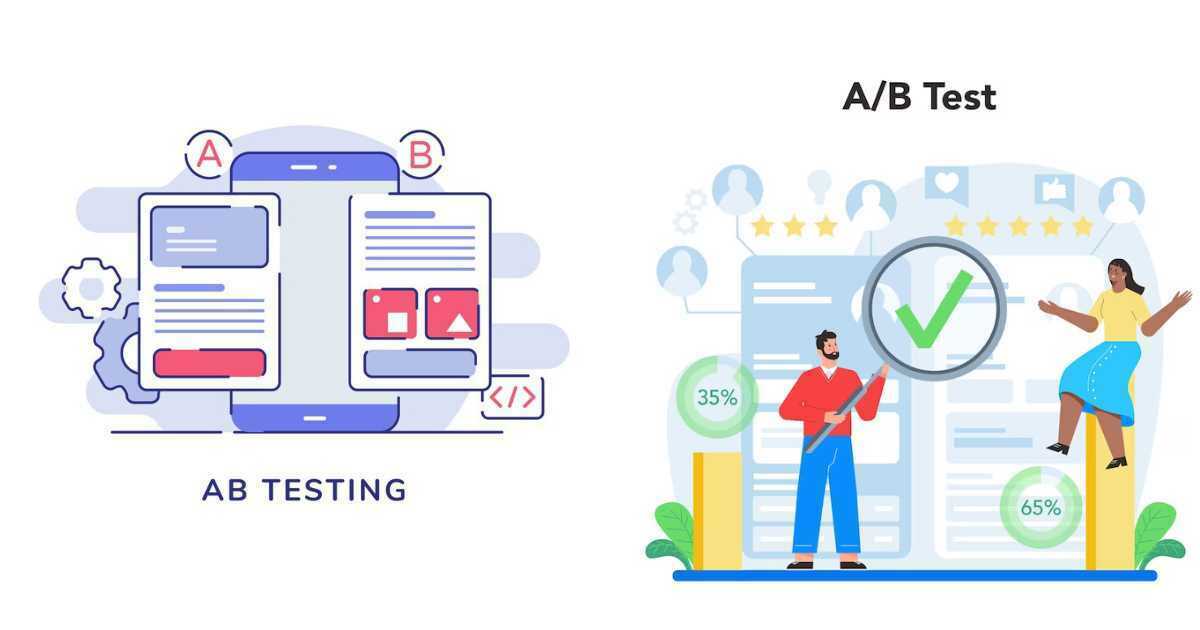Welcome to Best ab Testing Tools: Are you seeking strategies to improve your company? Do you know anything about A/B testing? A/B testing can help your website, app, or advertising campaigns become more effective. In this article, we’ll go over what AB testing is, how it works, and how it may benefit your Business.
1. Introduction
Comparing two versions of a website, app, or marketing campaign with ab testing allows you to see which one works better. You can assess the effects of changes in design, copy, or functionality by distributing various versions at random to various consumers. This enables you to make informed choices that may result in higher conversion rates, user engagement, and monetary benefits.
5 Best Ways A/B Testing Can Improve Your Business
A/B testing is a popular marketing technique used by businesses to test and optimize their websites, ads, and marketing campaigns. Here are five ways that A/B testing can improve your business:
1) Improve Conversion Rates: A/B testing allows you to test different variations of your website or marketing campaign to see which one performs better. By identifying the elements that lead to higher conversion rates, you can optimize your website or campaign to improve your overall conversion rate.
2) Increase Engagement: A/B testing can also help you increase engagement with your audience by testing different variations of your content or messaging. By identifying the elements that resonate with your audience, you can create more engaging and effective content.
3) Reduce Bounce Rates: A/B testing can also help you reduce bounce rates by identifying the elements that cause users to leave your website or campaign. By optimizing these elements, you can reduce bounce rates and keep users engaged.
4) Optimize Ad Spend: A/B testing can help you optimize your ad spend by identifying the ads that perform best with your target audience. By focusing your ad spend on the most effective ads, you can improve your ROI and reduce wasted ad spend.
5) Improve User Experience: A/B testing can also help you improve the overall user experience of your website or campaign by identifying the elements that frustrate or confuse users. By optimizing these elements, you can create a more user-friendly experience that leads to higher engagement and conversion rates.
Get Started Free- Run your page through AB Testing.
2. What is A/B Testing?
ab testing is a scientific method of testing two versions of a webpage, app, or marketing campaign to determine which one performs better. Also known as split testing, ab testing involves showing one version (A) to a group of users and another version (B) to another group, then measuring which version achieves the desired outcome more effectively. ab testing can be used to improve various aspects of a website or app, including design, copy, functionality, and user experience.
3. How does A/B Testing work?
A/B Testing Typically Involves the Following Steps:
- Create two versions (A and B) of the element you want to test, such as a webpage, email, or ad.
- Randomly assign users to either group A or group B.
- Show Group A the original version (control) and Group B the new version (variation).
- Measure how each version performs in achieving the desired outcome, such as clicks, conversions, or revenue.
- Analyze the results and determine which version performed better.
4. Why is A/B Testing important?
A/B testing is important because it allows you to make data-driven decisions based on actual user behavior, rather than relying on assumptions or guesswork. By testing different versions of your website, app, or marketing campaign, you can identify the elements that are most effective in achieving your goals. This can lead to increased conversion rates, engagement, and revenue, as well as a better understanding of your target audience.
5. Benefits of A/B Testing for Your Business
Here are Some of the key Benefits of A/B Testing for your Business:
A) Increased Conversion Rates
AB testing can help you improve your conversion rates by identifying the elements that are most effective in driving user behavior. By testing different versions of your landing pages, forms, calls-to-action, or checkout processes, you can optimize your website or app for higher conversions and revenue.
B) Reduced Bounce Rates
A/B testing can also help you reduce your bounce rates by improving the relevance, clarity, and usability of your website or app. By testing different versions of your headlines, images, or navigation, you can create a more engaging and intuitive user experience that keeps users on your site longer.
C) Improved User Experience
A/B testing can also help you improve your overall user experience by identifying and fixing issues that may be hindering user engagement or satisfaction. By testing different versions of your site or app, you can pinpoint the elements that are causing frustration or confusion, and make adjustments accordingly.
D) Better ROI
By assisting you in streamlining your advertising campaigns for improved effectiveness, A/B testing can also result in a higher return on investment (ROI). You may enhance your targeting, messaging, and offers by experimenting with multiple versions of your ads, emails, or social media posts. This will increase click-through rates, conversions, and income.
E) Data-Driven Decisions
Additionally, A/B testing gives you the ability to make data-driven decisions that are founded on actual user behavior rather than guesswork or views. You may learn a lot about your target market, their tastes, and their behavior by running tests on several iterations of your website, mobile application, or marketing campaign. You can then utilize this knowledge to enhance the results of your business.
6. How to Conduct an A/B Test
The Main Steps in doing an A/B test are Listed Below:
- Identify the Goal of the Test: The first step in conducting an A/B test is to identify the goal of the test. What are you trying to achieve? Do you want to increase conversions, reduce bounce rates, or improve user engagement? Be clear about your goal before you start testing.
- Define Your Hypothesis: The next step is to define your hypothesis. What do you think will improve your desired outcome? What changes do you want to test? Write down your hypothesis in a clear and concise statement.
- Create Variations: The third step is to create variations of the element you want to test. This could be a landing page, a form, a call-to-action, or an ad. Be sure to create at least two versions (A and B) that are significantly different from each other, so that you can measure their impact accurately.
- Determine Sample Size: The fourth step is to determine your sample size. How many users do you need to test each version? Use a statistical calculator to ensure that your sample size is large enough to produce statistically significant results.
- Run the Test: The final phase involves carrying out the test. Assign people randomly to Version A or Version B using AB testing tools, and confirm that the test has been run for the appropriate amount of time.
- Analyze the Results: Analyzing the results is the last step. Compare the effectiveness of versions A and B using your AB testing tools to see if there is a statistically significant difference between them. If so, you can safely pick a winner and put the victorious version of your website or app into use.
- Tips for Effective A/B Testing:
Here are a few tips to conduct effective A/B tests:
a) Focus on essential components.
Focus on the important factors that are most likely to affect what you want to happen while running an A/B test. Your headline, call to action, or form fields may fall under this category.
b) Test One Element at a Time
To avoid confusion and ensure accurate results, test one element at a time. Don’t test multiple elements at once, as it will be difficult to determine which element is responsible for the change in performance.
c) Use a Statistical Calculator
Use a statistical calculator to determine your sample size and ensure that your results are statistically significant. This will help you avoid drawing inaccurate conclusions from your data.
d) Test Continuously
Don’t give up after one test because A/B testing is a continuous process. Test several iterations of your website or app frequently to make sure you are constantly enhancing performance.
e) Don’t Over-Optimize
Finally, avoid over-optimizing. Don’t compromise other key elements, like your brand identity or messaging, in the course of enhancing your conversion rates and user experience.
Conclusion
Making data-driven decisions based on user behavior with AB testing is a powerful tool that can help you improve your website, app, or marketing campaign. You may find the components that are most helpful in accomplishing your goals by testing numerous versions of your website or app, which will enhance conversion rates, engagement, and income. To make sure that your A/B testing is successful and produces insightful findings, adhere to the advice and best practices provided in this article.
FAQs
Q: What is A/B testing?
A: AB testing is a method of testing different versions of a website, app, or marketing campaign to determine which version performs better.
Q: How does A/B testing work?
A: AB testing works by randomly assigning users to either version A or version B, and measuring the performance of each version to determine which one is more effective.
Q: What are the benefits of A/B testing?
A: The benefits of A/B testing include increased conversion rates, reduced bounce rates, improved user experience, better ROI, and data-driven decision-making.
Q: What are the key steps involved in conducting an A/B test?
A: The key steps involved in conducting an A/B test include identifying the goal of the test, defining your hypothesis, creating variations, determining sample size, running the test, and analyzing the results.
Q: What are some tips for successful A/B testing?
A: Tips for successful AB testing include focusing on key elements, testing one element at a time, using a statistical calculator, testing continuously, and not over-optimizing.
Also, Read- 5 Tips to Improve Your Conversion Rate Optimization


